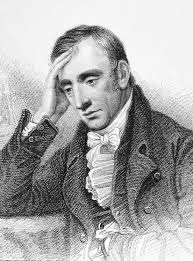Daffodils by William Wordsworth
The poem was written in the year 1802. It was first published in Poems in Two Volumes, in 1807. The very starting line of the poem “I wandered lonely as a cloud” informs the poets profound sentiments of being left alone. It was actually the death of his brother John that led him to “loneliness”. We should remind the readers that this poem was not a result of imagination. Dorothy, Wordsworth’s sister provides us an explanation of the occasion which inspired Wordsworth to produce this masterpiece:–
“When we were in the woods beyond Gowbarrow park, we saw a few daffodils close to waterside.” Thus the poem is a result of actual visualization rather than imagery”.
In the beginning lines, Wordsworth describes himself as a ‘cloud’ that floats over the hills. This presents an idea of seclusion. The idea of being alone is contradicted by the phrase “crowd”. This is actually the ‘setting of the poem‘. As human form Wordsworth prefers seclusion but the ‘crowd’ of daffodils bewilders his senses. The feeling of ecstasy suddenly makes a dive.
Once the poet was wandering pointlessly beside a lake, he was all alone to wander freely akin to a patch of clouds floating in the sky, over the valleys and the hill. Suddenly he could view the large number of daffodils gathered by the side of the lake. They were sheltered under a growing tree. The Daffodils resembles the color of gold(1) (according to the poet)and the airy breeze made them wave and dance, rejoice and play. The poet however could not estimate their number as they spread along extensive sides of the lake.
Daffodils is a commonly grown flower.The line: ‘A host, of golden daffodils;’ needs a special mention since it unveils the poet’s thoughts. Wordsworth associated the colour of richness: Gold; to his common flower.
They resemble akin to innumerable shining stars that one could see in the night sky in the form of Milky Way. As the poet made an instant glance, he could see myriad of daffodils waving their heads, as if they were rejoicing and dancing out of alacrity. Seeing this, the waves of the lake accompanied dancing along with these daffodils, but their lustrous dance was in no way comparable to the delight and gaiety of the flowers the poets seems to have frenzied with; an ecstasy of delight.
He realized that a poet who was susceptible to natural grace could not help but feel happy in the presence of such gay and beautiful flowers. He gazed at them, hardly knowing what enormous treasure he was accumulating in his mind.
That vista was impregnated in the poet’s mind for an everlasting time. In future, when the poet lied down on his couch, either in a lonely or a pensive mood, the entire panorama that he saw in the woods beyond the Gowbarrow Park appeared before his mind’s eye. In solitude, when his mind is unrestrained by disturbing elements of the real world, he revives the memories of the daffodils. When the memory of that sight comes into view of the poet, he was able to derive ecstatic pleasure which he had enjoyed actually.





Comments
Post a Comment